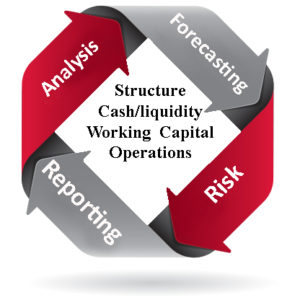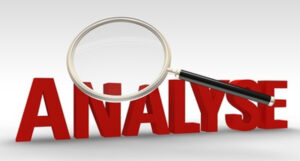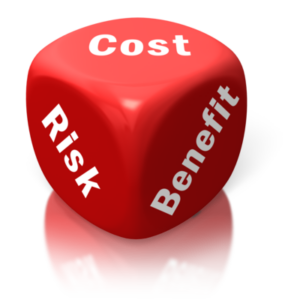
the cfo system
The CFO System focuses on four key segments of business – Financial structure, Operations, Cash flow and Liquidity and Working Capital. Each of these segments as denoted in the graph below is constantly analyzed, forecasted risk assessed and reported. We have been using this system for over 30 years quite successfully.

structure
This the financial structure of the business. Included are balance sheet structure (debt/equity), leverage, valuation, stakeholder analysis, fixed assets, financial metrics, business planning,
operations
This basically involves the income statement, but also includes customer profitability, breakeven, contribution margins, discretionary expenses, return on investment, sustainable growth and vendor analysis.
cash flow and liquidity
Liquidity, free cash flow, credit and collections, treasury management, banking and finance, sources and uses short and long term. Absence of liquidity is the prime driver of bankruptcy.
working capital
Working capital is the foundation of the business. While not cash, working capital is closely tied to cash resources. How much is enough? Can there he too much? Key questions for this key metric.

Analysis
This process is the most underused, yet most important for business success. While analyzing a business appears to be a practical notion, there just doesn’t seem to be enough time by existing staff to make it a priority. Ideally analysis of financial matters as well as other management issues is best done monthly; it should be done at least quarterly. Are we doing something a controller or CFO cannot do themselves? No, it becomes a matter of timing when so much day to day activities squeeze the time of internal professionals. This is why we are used to help these professionals creating a greater efficiency and ultimately greater business success

Forecasting
Forecasting is NOT budgeting. Humans are generally creatures of habit unless something or someone compels a change. This is borne out by trends including business. We have effectively used forecasting tools to help predict the future and whether business decision making should include a change that compels others to change; whether this be customers, vendors, and even employees

Risk
Measuring financial risk is an art that comes with years of measuring and testing; years we have in place. Risk management comes with experience. Measures include banking and finance, employment issues, economic, property damage, taxation and regulation and most notably, succession. In almost every case we are able to quantify the risk and use our forecasting models to predict and measure outcomes.

Reporting
The method and detail of reporting is client driven. Some want details, others summary. Some want monthly while others want quarterly or annually. Most clients want quarterly reporting. There is one report almost no small to mid-sized business uses – the annual report. Large publically traded companies use annual reports and for good reason. This is why every business should create an annual report. Such a report provides a historical record of the entity, management review, actual CPA statements, analysis and optional forecasting. Almost every annual report we have assisted in preparation was met with positive results, especially from lenders as well as other inside and outside stake holders.